

This is a merged information page for Item #3429.
View normal product page.
Pololu item #:
3429
Brand:
FEETECH

The FEETECH FT5335M servo is all about torque. This 1/4-scale digital servo can deliver an incredible 550 oz-in of torque at 7.4 V or 480 oz-in at 6 V thanks to its powerful motor and all-metal gear train. The FT5335M is a high-voltage servo, offering an operating voltage range of 6 V to 7.4 V. Servo horns and associated hardware are included. This servo can work with both 5 V and 3.3 V servo signals.
Key specs at 7.4 V: 0.18 sec/60°, 550 oz-in (40 kg-cm), 180 g.
 Compare all products in RC Servos or
Compare all products in RC Servos or  FEETECH Servos.
FEETECH Servos.
 |
FEETECH Ultra-High-Torque, High-Voltage Digital Giant Servo FT5335M. |
|---|
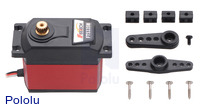 |
FEETECH Ultra-High-Torque, High-Voltage Digital Giant Servo FT5335M with included hardware (actual hardware might vary). |
|---|
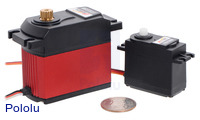 |
FEETECH Ultra-High-Torque, High-Voltage Digital Giant Servo FT5335M compared to a standard-size servo. |
|---|
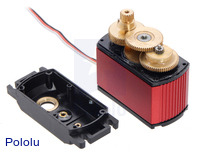 |
The FEETECH Ultra-High-Torque, High-Voltage Digital Giant Servo FT5335M has an all-metal gear train. |
|---|
 |
Futaba J connector at the end of the FEETECH FT5335M servo cable. |
|---|
 |
The FEETECH FT5335M and Power HD 1235MG giant servos have very similar dimensions and performance. |
|---|
May 2023 update: Feetech has changed the case color of these from red to silver. The dimensions and functionality remain the same.
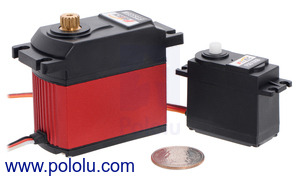 |
The FT5335M is a giant-scale (also called 1/4-scale or mega-scale) digital servo from FEETECH that can deliver more than twice the torque of our strongest standard-size servo, offering up to 550 oz-in at 7.4V or 480 oz-in at 6 V (if you need even more torque than this, check out the much larger Torxis monster servos, and if you need a lot of torque in a smaller size or with more speed, consider the FT5121M and FT5313M high-torque digital servos). The picture on the right shows how the giant-size FT5335M compares to a standard-size servo.
The FT5335M works with standard RC servo pulses, providing a running angle of approximately 120° over a servo pulse range of 900 µs to 2100 µs. Many hobby servos can be operated beyond their standard ranges by using a wider pulse range, but please note that in our tests, we were not able to expand the range of the FT5335M significantly beyond 120° (the servo did not respond to pulses below around 900 µs or above around 2100 µs).
This servo has a 12″ (30 cm) cable that is terminated with a standard Futaba J connector. Unlike typical hobby servos, the FT5335M has an operating voltage range of 6 V to 7.4 V.
Note: This servo can draw bursts of current in excess of 9 A at 7.4 V, so please make sure you have an appropriate power supply. For comparison, a typical standard-size servo might draw around an amp when straining.
|
|
For more advanced robotics applications, please note that we also carry a version of this servo that is specially modified to provide access to the feedback potentiometer through a fourth (green) wire, which lets you monitor the actual position of the servo from your controller:
 |
FEETECH Ultra-High-Torque, High-Voltage Digital Giant Servo FT5335M-FB with Position Feedback. |
|---|
The included servo horns are plastic, but we also carry a compatible metal horn (sold separately) that can be used as a more robust lever arm in ultra-high-torque applications:
|
|
The picture below shows the all-metal gear train that helps the servo deliver such high torque:
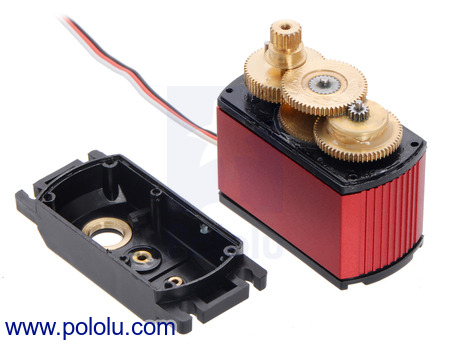 |
You can find more information about this servo in its datasheet (111k pdf).
Note that, as with most hobby servos, stalling or back-driving this servo can damage it.
This servo is a lower-cost alternative to the very similar 1235MG from Power HD. The two servos are approximately the same size, though the mounting hole spacing differs between the two, and they have almost identical performance specifications. The output shaft of the 1235MG is supported by two ball bearings for reduced friction while the output shaft of the FT5335M is supported by bushings. The picture below shows both the FT5335M and the 1235MG side by side:
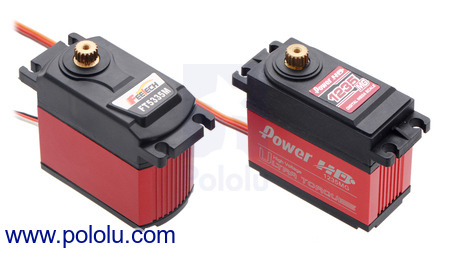 |
The servo output splines have the same number of teeth, but the diameter of the one on the FT5335M is approximately 0.2 mm bigger. This means that the servo horns included with the FT5335M can be used with the 1235MG, but not the other way around.
| Size: | 62.8 × 32.5 × 55.9 mm |
|---|---|
| Weight: | 180 g |
| Digital?: | Y |
|---|---|
| Speed @ 7.4V: | 0.18 sec/60° |
| Stall torque @ 7.4V: | 40 kg·cm |
| Speed @ 6V: | 0.20 sec/60° |
| Stall torque @ 6V: | 35 kg·cm |
| Hardware included?: | Y |
| Lead length: | 12 in |
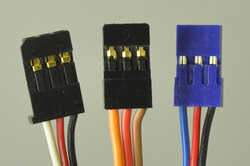 |
Most standard radio control (RC) servos have three wires, each a different color. Usually, they are either black, red, and white, or they are brown, red, and orange/yellow:
Please check the specs for your servo to determine the proper power supply voltage, and please take care to plug the servo into your device in the proper orientation (plugging it in backwards could break the servo or your device).
Note: Some of the servos we carry also have an optional fourth green wire that is separate from the three standard ones. This wire provides access to the feedback potentiometer, allowing you to directly measure the position of the output. The servos with this extra wire have "with Position Feedback" at the ends of their product names. The picture below is an example of such a servo.
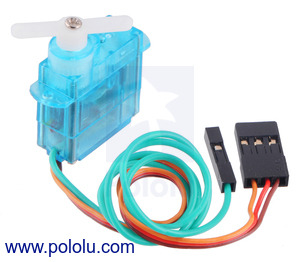 |
FEETECH Sub-Micro Servo FS0403-FB with Position Feedback. |
|---|
We do not specify the range of rotation of our servos because this information is not generally available from servo manufacturers. RC servos are usually intended for controlling things like the steering mechanism in an RC car or the flaps on an RC plane. Manufacturers make sure that the range is enough for these typical applications, but they do not guarantee performance over a wider range.
This means most RC servos will rotate about 90° using the standard 1–2 ms pulse range used by most RC receivers. However, if you are using a controller capable of sending a wider range of pulses, many servos can rotate through almost 180°.
You can find a servo’s limits if you use a servo controller that can send pulses outside of the standard range (such as our Maestro servo controllers). To find the limits, use the lowest possible supply voltage at which the servo moves, and gradually increase or decrease the pulse width until the servo does not move any further or you hear the servo straining. Once the limit is reached, immediately move away from it to avoid damaging the servo, and configure your controller to never go past the limit.
You might be wondering why we do not just follow the above steps for all the servos we carry and list a specification for degrees of rotation. Unfortunately, since servo manufacturers do not specify the range of rotation, it might change from one manufacturing run to the next. They will not inform us about changes that are not specified, and we have no way of knowing if or when they might change their manufacturing process.
For more information about servos and how to control them, we recommend the series of blog posts on servos starting with: Introduction to servos.
We have expanded our selection of specially modified FEETECH servos that have direct access to the feedback potentiometer through an extra fourth...
We added the FEETECH Ultra-High-Torque, High-Voltage Digital Giant Servo FT5335M to our expanding RC servo selection. This giant-scale digital servo...